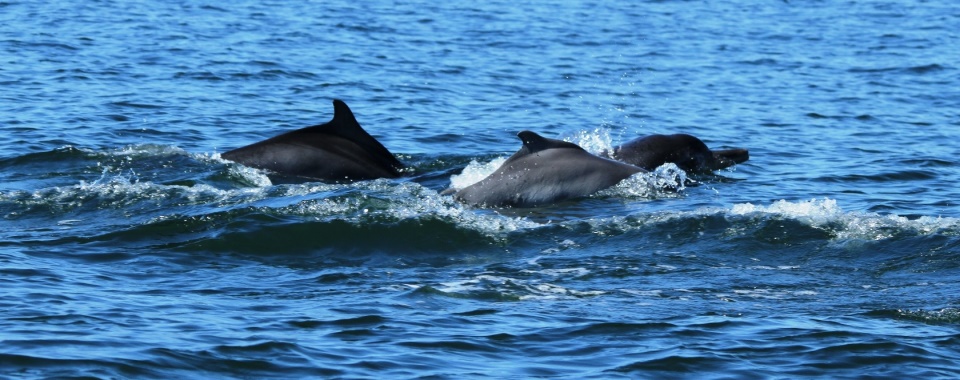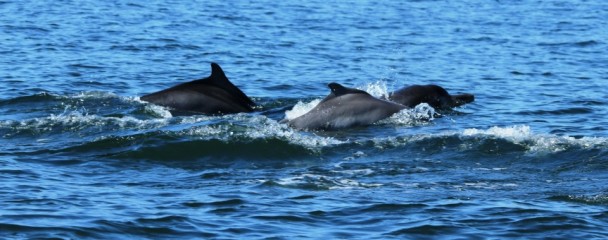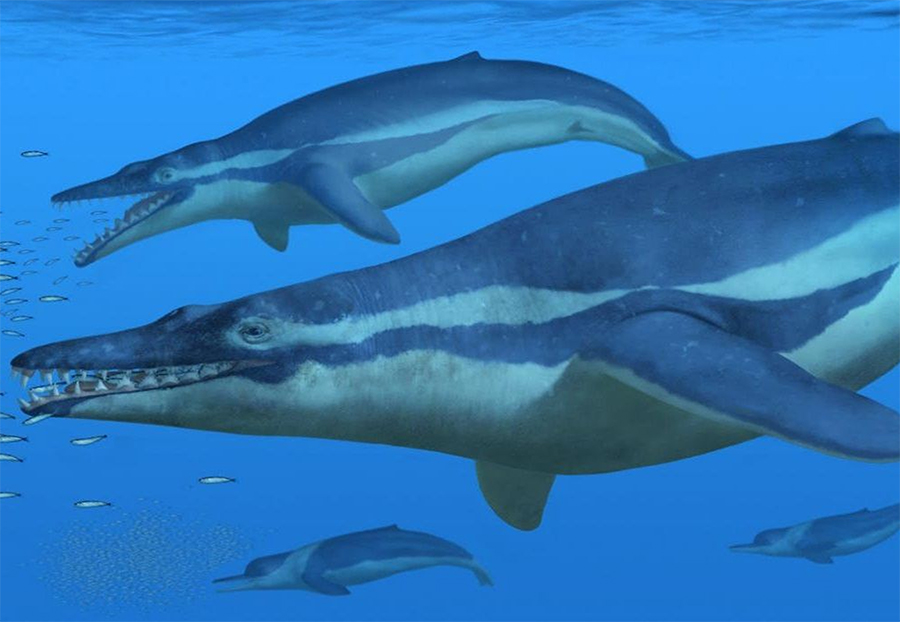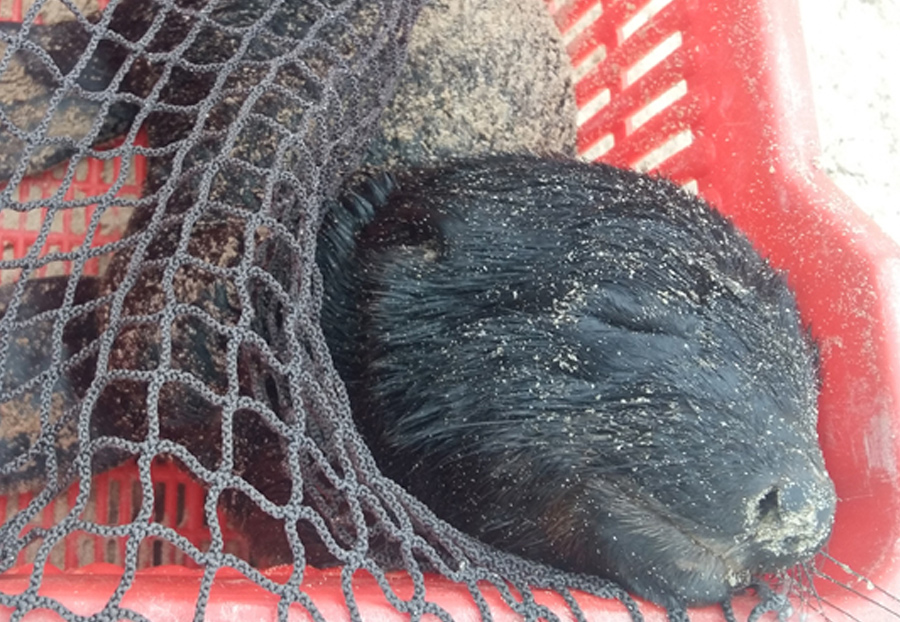Interesting Facts about Humpback dolphins (Sousa sp.)
One of the dolphin species seen on a regular basis in Plettenberg Bay is the humpback dolphin. In the world there are 4 species of humpback dolphin, the Atlantic humpback dolphin (Sousa teuszii) and 3 types of Indo-Pacific humpback dolphins (S. plumbea, S. chinensis and S. sahulensis). For a long time it was believed that only 1 species was found in the Indian and Pacific Ocean and there is still debate if the S. plumbea and S. chinensis are one species. In 2014 Australian scientists determined that the humpback dolphins found around their coastline are different to those already described, and it has been named Sousa sahulensis. Most scientists agree that from South Africa to the west coast of India S. plumbea can be found and from there to the Pacific Ocean S. chinensis. From now on the information will be about the humpback dolphins found in South African waters (S. plumbea).
Humpback dolphins are grey with a darker dorsal than ventral side. They are stockily built with a long slender beak and distinct hump on the back under the dorsal fin. Males grow to 2.8m and females to 2.5m with a maximum weight of 285kg. Humpback dolphin calves are born at around 1m in length and 14kg, they are generally darker in colour than the adults. They can live for over 40 years.
Humpback dolphins are found in shallow waters, generally never deeper than 25m in bays, lagoons, estuaries, and around rocky and coral reefs. In South Africa they can be found from False Bay in the west to Mozambique in the east. Most humpback dolphin populations seem to have a home range of 120-200km.
Female humpback dolphins reach sexual maturity at 10 years of age, while males sexually mature around 12-13 years of age. Their gestation period is 11-12 months and they give birth all year round, but mainly in spring/summer. The theory why more calves are born in spring/summer is that there is higher food abundance during those months, allowing the mothers to have a high uptake of energy when nursing their calves. The calves will be weaned at around 2 years of age, but from as early as 6 months they will start mixing milk with solid food. It seems that they give birth ever 3-4 years.
The typical surfacing behaviour for humpback dolphins is to break the surface with the beak before the rest of the head and top part of the body appears. This technique seems to give the blowhole a longer exposure to air, thereby increasing their dive times. Humpback dolphins are found in small pods usually consisting of 2-4 individuals but a maximum of 25 has been recorded. They are seen feeding around reefs, river mouths and estuaries on small fish, squid and octopuses. In 1994 scientists observed humpback dolphins using a beaching technique to catch fish in Mozambique (Peddemors and Thompson). The dolphins would beach themselves after herding fish into shallow waters and then up onto the beach. They then reach the fish with their long beaks before sliding back into the water. They are mainly seen hunting solo for their food.
The main predators of humpback dolphins are Great white sharks and possibly Orcas. Other threats to the population are shark nets, fishing gear and bioaccumulation . On the IUCN endangered animals list humpback dolphins are classified as near threaten, but that classification included S. plumbea and S. chinensis as one species In order for a species to be classified as vulnerable, it must have a population size less than 10,000 individuals. If the two types are assessed separately then each will be classified as vulnerable species, both showing a decrease in numbers. All abundance estimations for S. plumbea in different locations along the coastline have resulted in less than 500 animals in each area and less than 10,000 individuals in the whole population. In most locations where humpback dolphins are found there is little conservation actions taken to protect the species. Plettenberg Bay became an internationally recognised marine Hope Spot in December 2014 and the humpback dolphin was chosen as the iconic species for this area. This is due to its regular occurrence in our bay, but also because it is extremely vulnerable to threats from pollution, disturbance and a reduction in their prey sources.
References
– Cliff A.G. Pillay N, 2013 Humpback dolphin bycatch in the shark nets in KwaZulu-Natal, South Africa Bio. Con. 159 p. 442-449
– Barros N.B. Cockcroft V.G. 1991 prey of humpback dolphins (Souse Plumbea) stranded in Easter Cape Province South Africa Aqu. Mam. 17.3 p 134-136
– Peddemors V.M. Thompson G. 1994 beaching behaviour during shallow waters feeding by Humpback dolpgins Sousa plumbea Aqu. Mam 20.2 p. 65-67
– Karczmarski L. 1999 Group dynamics of humpback dolphins (Sousa chinensis) in the Algoa Bay region, South Africa J. Zool., Lond. 249, 283±293
– Karczmarski L. Thornton M. Cochcroft V.G. 1997 Description of selected behaviours of humpback dolphins Sousa chinensis aqu. Mam. 23.3 p. 127-133
– Jefferson T.A Karczmarski L. 2001 MAMMALIAN SPECIES Sousa chinensis American Society of Mammalogists No. 655, pp. 1-9, 3
– Jefferson T.A. Rosenbaum H.C 2014 Taxonomic revision of the humpback dolphins (Sousa spp.), and description of a new species from Australia. Mar. Mam. Sci. V. 30, I. 4, p. 1494–1541
– http://www.iucnredlist.org/details/20424/0
Books
– Whales dolphins and other marine mammals of the world (2006) by Hadoram Shirihai and Brett Jarrett. Prinston field guides 2006
– Smithers’ Mammals of Southern Africa a field Guide by Peter Apps Struik Nature edition 2012





